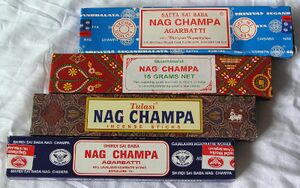Chemistry:Nag champa
Nag champa is a natural fragrance of India n origin. It is made from a combination of sandalwood and either champak[1][2] or frangipani.[3] When frangipani is used, the fragrance is usually referred to simply as champa.[4]
Nag champa is commonly used in incense, soap, perfume oil, essential oils, candles, wax melts, and personal toiletries.[5] It is a popular and recognizable incense fragrance.[6][4]
Composition
A number of flower species in India are known as champa or champak:[7]
- Magnolia champaca, formerly classified as Michelia champaca (swarna champa or yellow champa)
- Plumeria rubra (frangipani)
- Mesua ferrea (nagkeshar or nagchampa)
Of these—Magnolia champaca is mostly used to prepare the nag champa scent,[6][8] while Plumeria or Mesua ferrea may be used for scents termed champa and sometimes nag champa.[9][7]
Nag champa perfume ingredients vary with the manufacturer, though generally they include sandalwood and magnolia,[1] which, as the plant is related to star anise, gives the scent a little spice. Other ingredients will depend on the finished product. Perfume-dipped incenses and soaps would use essential oils or scents, while masala incenses would use finely ground fragrant ingredients as well as essential oils.[5]
References
- ↑ 1.0 1.1 Stephanie Rose Bird (2006). Four Seasons of Mojo: An Herbal Guide to Natural Living. Llewellyn Worldwide. p. 67. ISBN 9780738706283. https://books.google.com/books?id=O6y58n263fEC&pg=PA67.
- ↑ Margaret Ann Lembo (2006). The Essential Guide to Aromatherapy and Vibrational Healing. Llewellyn Worldwide. p. 41. ISBN 9780738747781. https://books.google.com/books?id=7LCcCwAAQBAJ&pg=PT41.
- ↑ Tomás Prower (1 Oct 2015). La Santa Muerte. Llewellyn Worldwide. p. 99. ISBN 9780738745510. https://books.google.com/books?id=ECSLCgAAQBAJ&pg=PT99.
- ↑ 4.0 4.1 Alaric Albertsson (8 Nov 2013). To Walk a Pagan Path. Llewellyn Worldwide. p. 232. ISBN 9780738739229. https://books.google.com/books?id=XesMAQAAQBAJ&pg=PA232.
- ↑ 5.0 5.1 Som Nath Mahindru (1992). Indian plant perfumes. Metropolitan. p. 107.
- ↑ 6.0 6.1 Natural Scents. "Nag Champa Ingredients". https://naturalscents.net/incense/nag-champa-incense-sticks-34.
- ↑ 7.0 7.1 Robert Beer (1999). The Encyclopedia of Tibetan Symbols and Motifs. Serindia. p. 50. ISBN 9780906026489. https://books.google.co.uk/books?redir_esc=y&id=3IvrAAAAMAAJ&focus=searchwithinvolume&q=Mesua+ferrea.
- ↑ Stephanie Rose Bird (2006). Four Seasons of Mojo: An Herbal Guide to Natural Living. Llewellyn. p. 67. ISBN 978-0-7387-0628-3. https://archive.org/details/fourseasonsofmoj0000bird.
- ↑ Tess Whitehurst (2013). The Magic of Flowers: A Guide to Their Metaphysical Uses & Properties. Llewellyn Worldwide. pp. 295–. ISBN 978-0-7387-3194-0. https://books.google.com/books?id=8cVe2KEbyDIC&pg=PA295.
External links
 |


